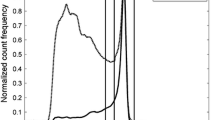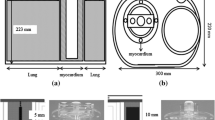Abstract
Poor and variable spatial resolution of the gamma camera, the movement of the heart and, above all, the inclusion of scattered photons in the acquisition data contribute to the deterioration of image contrast in201T1 myocardium perfusion studies. Scatter correction algorithms may correct for the latter factor by removing (most of) the scattered photons from the acquisition data.Methods: In this study we investigated the contrast changes induced by the Triple Energy Window scatter correction method (TEW) applied to clinical201T1 myocardium perfusion studies and its influence on the reading of the images. Stress and rest studies of 30 consecutive patients were used for this study. Maximum image contrasts were measured between the myocardium and the left ventricular cavity in four mid-ventricular short axis slices, as well as between normally and abnormally perfused myocardium using bull’s-eye displays of the activity within the myocardium. To assess image quality and perfusion abnormalities, an experienced nuclear medicine physician, blind to patient characteristics, visually reviewed all studies.Results: In all individual measurements, the maximum contrast after scatter correction was higher than without correction (p < 0.001). The average increase in contrast between the myocardium and the left ventricular cavity was 43% and 48% for stress and rest studies respectively. The contrast within the myocardium increased by 25% and 32% respectively. After TEW, image quality was rated lower in almost half of the studies, while in only one study the quality was rated higher. In stress studies 11 additional perfusion defects were observed, with rest studies revealing 15 more defects after TEW, but this difference was not significant. Cohen’s kappa indicated a moderate agreement of the image reading between studies with and without scatter correction.Conclusion: We conclude that image contrast improves significantly by scatter correction. However, image quality decreased as a result of an unfavorable signal-to-noise ratio. As an overall result, no significant change in the clinical outcome of the studies could be shown. Additional training of the readers may be required to obtain optimal results.
Similar content being viewed by others
References
Kiat H, Germano G, Friedman J, Van Train K, Silagan G, Wang FP, et al. Comparative feasibility of separate or simultaneous rest thallium-201 /stress technetium-99m- sestamibi dual-isotope myocardial perfusion SPECT.J Nucl Med 1994; 35:542–548.
Lowe VJ, Greer KL, Hanson MW, Jaszczak RJ, Coleman RE. Cardiac phantom evaluation of simultaneously acquired dual-isotope rest thallium-201/stress technetium- 99m SPECT images [see comments].J Nucl Med 1993; 34:1998–2006.
Ando H, Fukuyama T, Mitsuoka W, Egashira S, Imamura Y, Masaki H, et al. Influence of downscatter in simultaneously acquired thallium-201/technetium-99m-PYP SPECT.J Nucl Med 1996; 37:781–785.
Axelsson B, Msaki P, Israelsson A. Subtraction of Compton-scattered photons in single-photon emission computerized tomography.J Nucl Med 1984; 25:490–494.
Msaki P, Axelsson B, Dahl CM, Larsson SA. Generalized scatter correction method in SPECT using point scatter distribution functions.J Nucl Med 1987; 28:1861–1869.
Naimuddin S, Hasegawa B, Mistretta CA. Scatter-glare correction using a convolution algorithm with variable weighting.Med Phys 1987; 14:330–334.
Singh M, Horne C. Use of a germanium detector to optimize scatter correction in SPECT.J Nucl Med 1987; 28:1853- 1860.
Halama JR, Henkin RE, Friend LE. Gamma camera radionuclide images: improved contrast with energy-weighted acquisition.Radiology 1988; 169:533–538.
Mukai T, Links JM, Douglass KH, Wagner HN Jr. Scatter correction in SPECT using non-uniform attenuation data.Phys Med Biol 1988; 33:1129–1140.
Fleming JS. A technique for using CT images in attenuation correction and quantification in SPECT.Nucl Med Commun 1989; 10:83–97.
Wagner FC, Macovski A, Nishimura DG. Two interpolating filters for scatter estimation.Med Phys 1989; 16:747- 757.
Mas J, Hannequin P, Ben Younes R, Bellaton B, Bidet R. Scatter correction in planar imaging and SPECT by constrained factor analysis of dynamic structures (FADS).Phys Med Biol 1990; 35:1451–1465.
Koral KF, Swailem FM, Buchbinder S, Clinthorne NH, Rogers WL, Tsui BM. SPECT dual-energy-window Compton correction: scatter multiplier required for quantification.J Nucl Med 1990; 31:90–98.
King MA, Hademenos GJ, Glick SJ. A dual-photopeak window method for scatter correction.J Nucl Med 1992; 33:605–612.
Ogawa K. Simulation study of triple-energy-window scatter correction in combined Tl-201, Tc-99m SPECT.Ann Nucl Med 1994; 8:277–281.
Pretorius PH, van Rensburg AJ, van Aswegen A, Lotter MG, Serfontein DE, Herbst CP. The channel ratio method of scatter correction for radionuclide image quantitation.J Nucl Med 1993; 34:330–335.
Meikle SR, Hutton BF, Bailey DL. A transmission-dependent method for scatter correction in SPECT.J Nucl Med 1994; 35:360–367.
Chen EQ, Lam CF. Predictor-corrector with cubic spline method for spectrum estimation in Compton scatter correction of SPECT.Comput Biol Med 1994; 24:229–242.
Buvat I, Rodriguez Villafuerte M, Todd Pokropek A, Benali H, Di Paola R. Comparative assessment of nine scatter correction methods based on spectral analysis using Monte Carlo simulations.J Nucl Med 1995; 36:1476–1488.
Ljungberg M, King MA, Hademenos GJ, Strand SE. Comparison of four scatter correction methods using Monte Carlo simulated source distributions.J Nucl Med 1994; 35:143–151.
van Eck SmitBL, van derWallEE, Zwinderman AH, Pauwels EK. Clinical value of immediate thallium-201 reinjection imaging for the detection of ischaemic heart disease.Eur Heart J 1995; 16:410–420.
Maddahi J, Van-Train K, Prigent F, Garcia EV, Friedman J, Ostrzega E, et al. Quantitative single photon emission computed thallium-201 tomography for detection and localization of coronary artery disease: optimization and prospective validation of a new technique.J Am Coll Cardiol 1989; 14:1689–1699.
Blokland KAK, Winn RDR, Pauwels EKJ. Signal to noise ratio based filter optimization in triple energy window scatter correction.Medical Physics 2000; 27:1955–1960.
Yang JT, Yamamoto K, Sadato N, Tsuchida T, Takahashi N, Hayashi N, et al. Clinical value of triple-energy window scatter correction in simultaneous dual-isotope single-photon emission tomography with123I-BMIPP and20lTl.Eur J Nucl Med 1997; 24:1099–1106.
El Fakhri G, Buvat I, Benali H, Todd Pokropek A, Di Paola R. Relative impact of scatter, collimator response, attenuation, and finite spatial resolution corrections in cardiac SPECT.J Nucl Med 2000; 41:1400–1408.
Gustafsson A, Arlig A, Jacobsson L, Ljungberg M, Wikkelso C. Dual-window scatter correction and energy window setting in cerebral blood flow SPECT: a Monte Carlo study.Physics In Medicine And Biology 2000; 45:3431–3440.
Perisinakis K, Karkavitsas N, Damilakis J, Gourtsoyiannis N. Effect of dual and triple energy window scatter correction methods on image quality in liver scintigraphy.Nuklearmedizin 1998; 37:239–244.
Author information
Authors and Affiliations
Corresponding author
Rights and permissions
About this article
Cite this article
Blokland, K.(.A.K., de Vos tot Nederveen Cappel, W.H., van Eck-Smit, B.L.F. et al. Scatter correction on its own increases image contrast in TI-201 myocardium perfusion scintigraphy, but does it also improve diagnostic accuracy?. Ann Nucl Med 17, 725–731 (2003). https://doi.org/10.1007/BF02984983
Received:
Accepted:
Issue Date:
DOI: https://doi.org/10.1007/BF02984983




